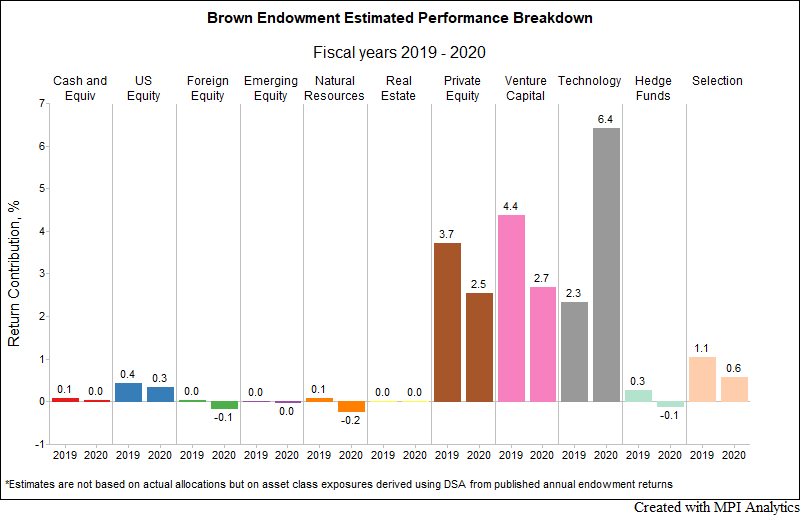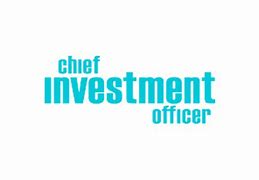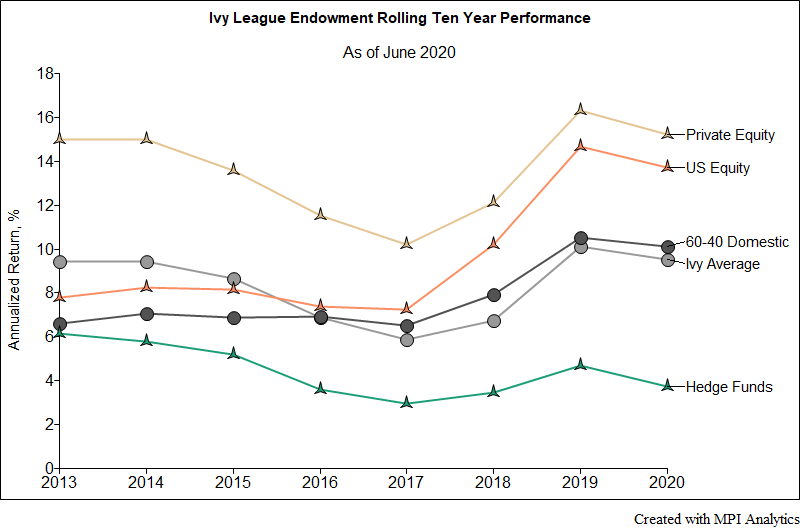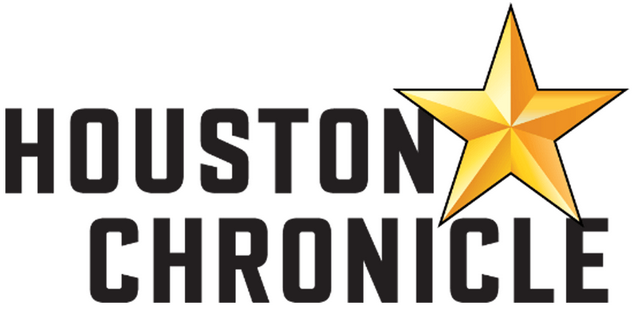
For the second straight year, Brown outperformed all other Ivy endowments by a large margin. Our research team, using MPI Stylus Pro to dissect the endowment annual returns, provides a plausible explanation of the endowment’s spectacular results.

For the second straight year, Brown outperformed all other Ivy endowments by a large margin. Our research team, using MPI Stylus Pro to dissect the endowment annual returns, provides a plausible explanation of the endowment’s spectacular results.

Read more on MPI’s annual assessment of the Ivy League Endowments, featured in Chief Investment Officer, where our analysts provide a deeper look into FY20 performance and the likely reasons behind the sharp drop over FY19.

We take a quick look at Ivy schools’ endowments’ performance results both for the 2020 fiscal year and also long-term for 10-year periods.

“…how was it possible for so many endowments to make bad choices among private equity and venture capital funds? The following chart from Markov suggests that it is down to outlandishly wide variations in performance within the private equity/venture capital world,” writes John Authers about MPI’s research in his opinion piece on Bloomberg.

Ian McGugan, investing columnist at Canada’s premier daily Globe & Mail wrote a column reviewing the decade and discussing why beta was so hard to beat has a prominent mention of the Ivy endowments’ failure to beat a 60/40 portfolio and MPI’s research.

“The quantitative analysis firm has a method for back-solving portfolios using returns rather than squishy self-reported allocations, and produced a study for Institutional Investor,” writes Leanna Orr about MPI in her article “David Swensen Is Great for Yale. Is He Horrible for Investing?”

“Bowdoin posted an 8.8 percent average annual return over the 10 years that ended June 30, handily beating the 6 percent average for all college endowments with assets of more than $1 billion, according to a national study. The school also outperformed all eight Ivy League endowments, none of which managed to beat the 8.1 percent average annual performance of a plain vanilla portfolio consisting of stock and bond indexes, according to Markov Processes International, a research firm.” Read the full article here. (subscription required)

“One way to look at a fund’s performance is by its growth in market value. Another way is to examine its returns. Analysts at Markov Processes International, a global investment research and technology firm, estimated that the fund was performing comparable to the worst-performing Ivy League endowments. One hundred dollars invested in the top-performing Ivy League endowments about a decade ago would be worth roughly $250 now. The Ivy average came in at about $220. The same cash put in the Permanent School Fund would now be valued at about $190. Read the full article here.

“Public pension funds aren’t the only institutions to fail to benefit from the heady promise of alternatives. The performance of Ivy League endowments has trailed a passive portfolio of 60 percent U.S. stocks and 40 percent bonds over the past ten years — and has been more volatile to boot, according to a report from research and analytics provider Markov Processes International.” Read the full article here.

In the 1990s, it pioneered a strategy that has since become the preferred approach for the endowments of many of the continent’s top universities and foundations. The Yale model consists of pouring money into opportunities that aren’t as thoroughly picked over as public stock and bond markets–areas such as timberland, hedge funds and private-equity deals. In theory, this makes sense. Investors should derive a reward for taking on the additional work and risk that goes along with venturing into the dimmer corners of the financial markets. But in practice the Yale model has been inconsistent. It beat a 60/40 approach during its early years; more recently, it’s looked strictly ho-hum. In fact, over the past 10 years, the endowments for Yale and all the other Ivy League schools in the United States failed to match the performance of a standard 60/40 portfolio, according to a recent study by (MPI), an investment research and software firm. Read the full article here. (subscription required)